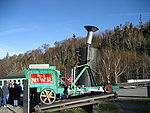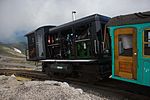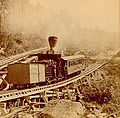- Mount Washington Cog Railway
-
For the defunct railway in Los Angeles, see Los Angeles and Mount Washington Railway.
Mount Washington Cog Railway 
Track with rackLocale Coös County, New Hampshire, USA Dates of operation 1868–Present Track gauge 4 ft 8 in (1,422 mm) Length 3 miles (4.8 km)[1] Headquarters Bretton Woods Mt. Washington Cog Railway Legend


Mount Washington Summit 


Appalachian Trail 


Skyline Siding 


Waumbek Siding 


Marshfield Station 


Boston & Maine Railroad to Fabyan (Carroll) The Mount Washington Cog Railway is the world's first mountain-climbing cog railway (rack-and-pinion railway). It uses a Marsh rack system to climb Mount Washington in New Hampshire, USA.
The railway ascends the mountain beginning at an elevation of approximately 2,700 feet (820 m) above sea level and ending at the summit of Mt. Washington at an elevation of 6,288 feet (1,917 m). It is the second steepest rack railway in the world[2] with an average grade of over 25% and a maximum grade of 37.41%. The railway is still in operation, using one or two steam locomotives and four biodiesel powered locomotives. The train ascends the mountain at 2.8 miles per hour (4.5 km/h) and descends at 4.6 mph (7.4 km/h), although the diesel can go up in as little as 37 minutes. It takes approximately 65 minutes to ascend and 40 minutes to descend. The railway is approximately 3 miles (4.8 km) long.
Most of the Mount Washington Cog Railway is in Thompson and Meserve's Purchase, with the part of the railway nearest to Mt. Washington's summit being in Sargent's Purchase.
Contents
History
The railway was built by Sylvester Marsh (1803-1884) [3] of Campton, who came up with the idea while climbing the mountain in 1857. His plan was treated as insane. Local tradition says the state legislature voted permission based on a consensus that harm resulting from operating it was no issue — since the design was attempting the impossible — but benefits were guaranteed: The $5,000 of his own money he put up, and whatever else he could raise, would be spent largely locally, including building the Fabyan House hotel at nearby Fabyan Station to accommodate the expected tourists. The railway is sometimes called "Railway to the Moon" because one state legislator remarked during the proceedings that Marsh should not only be given a charter up Mount Washington but also to the moon. After developing a prototype locomotive and a short demonstration section of track, he found investors and started construction.
Despite its incomplete state, the first paying customers rode in 1868; the construction reached the summit in 1869. The early locomotives all had vertical boilers, like many stationary steam engines of the time; the boilers were mounted on trunnions allowing them to be held vertically no matter what the gradient of the track. Later designs introduced horizontal boilers, slanted so they remain close to horizontal on the steeply graded track.
Sylvester Marsh died in 1884 and control of the Cog passed to the Concord & Montreal Railroad, which ran it until 1889 when the Boston & Maine Railroad took over.[4]
Control by the Teagues began in 1931 when Col. Henry N. Teague bought the Cog. In 1951 following Col. Teague's death, Arthur S. Teague, the colonel's protégé but no relation, became general manager. Arthur S. Teague gained ownership in 1961. After he died in 1967, the ownership passed to his wife, Ellen Crawford Teague, who ran the Cog as the world's first woman president of a railway. In 1983 Mrs. Teague sold the railway to a group of New Hampshire businessmen.[1][4][5] The Cog has been in continuous operation since 1869 with service interruptions only during the World Wars.
In the summer of 2008, the Cog introduced its first diesel locomotive. The late 2000s recession and the 2000s energy crisis led to fewer passengers, and the Cog sought to cut costs with the diesel, which could make 3 round trips for the cost of one steam train round trip.[6]
Devil's shingle
Since the early days of the railway's construction the workers wanted to minimize time when climbing and descending the ramp, so they invented slideboards fitting over the cog rack and providing enough room for themselves and their tools. These boards – no two were exactly alike – were approximately 90 cm (35 in) long by 25 cm (9.8 in) wide, made of wood with hand-forged iron and with two long hardwood handles usually attached at the down-mountain end. Common times for the descent of the mountain using these boards were about 15 minutes. The record was 2:45, an average speed above 100 km/h (62 mph).[1]
The "Devil's shingles" were banned in 1906 after the accidental death of an employee. Later the design of the rack was changed so the old braking mechanism could not grip any more.
Accidents
The first of two major accidents in the railway's history occurred in 1929. The first locomotive, #1 (first named Hero and later Peppersass because of its vertical boiler's resemblance to a pepper sauce bottle) which was used to build the railway was found after being lost for many years as it had been moved about the country and placed on display at many exhibitions. The owners of the railway at the time (the Boston & Maine Railroad) decided to restore Peppersass and make a commemorative trip for the railway's 60th anniversary. During the ascent, however, the locomotive's front axle broke and the locomotive began descending the mountain at high speed. All but one of its crew jumped to safety (though some suffered broken bones), but one man did not escape and died. Although the locomotive broke into pieces, the boiler did not rupture, and the pieces were later reassembled to reconstruct the locomotive for static display. It is now located at the Cog Railway Base Station.[7]
On September 17, 1967, eight passengers were killed and seventy-two injured when Engine #3 derailed at the Skyline switch about a mile below the summit. The engine rolled off the trestle while the uncoupled passenger car slid several hundred feet into a large rock. An investigation revealed that the Skyline switch had not been properly configured for the descending train. The railway nonetheless has a solid safety record having taken almost five million people to the summit during its existence.
Mechanical design
Each train consists of a locomotive pushing a single passenger car up the mountain, and descending the mountain by going backwards. Both locomotive and car were originally equipped with a ratchet and pawl mechanism engaged during the climb that prevents any roll-back; during descent, both locomotive and car are braked. Recent improvements in design have replaced the ratchet (gear and pawl mechanism) with sprague clutches and disc brake assemblies. Most of the locomotives were made by the Manchester Locomotive Works.
The rack rail design used is one of Marsh's own invention, using a ladder-like rack with open bar rungs engaged by the teeth of the cog wheel. This system allows snow and debris to fall through the rack rather than lodge in it. A similar design, called the Riggenbach rack system, was invented by engineer Niklaus Riggenbach in Switzerland at about the same time. The Swiss Consul to the United States visited Marsh while constructing the railway up Mount Washington, and his enthusiastic reports persuaded the Swiss government to commission Riggenbach to build on Rigi Mountain the Vitznau-Rigi-Bahn, opened on May 21, 1871.
Initially, there was no way to pass on the Mount Washington Cog Railway. In 1941, a nine-motion switch was invented, and two spur sidings were added, each long enough to divert two up trains so others could pass down, enabling more round trips per day.
In 2004, work was completed replacing the lower Waumbek Switch and Siding with an 1,800-foot (550 m) passing loop equipped with electric and hydraulicly powered automated switches. These switches are powered by batteries and recharged by solar panels. One switch is located at each end of the loop, allowing ascending and descending trains to pass one another.[8]
Modern operations
The most common trips on the Cog Railway are between the two main stations, one at the summit and the other adjacent to the operators' logistical and repair base.
From 2003 to 2006, "ski trains" ran, stopping at an intermediate station, from which passengers could ski down to the Base Station.
The Cog Railway track crosses a hiking trail a relatively short distance below the summit of Mount Washington, and some hikers wait for the next train in order to moon the passengers. This practice is known as "Mooning the Cog." Several hikers were arrested for performing this ritual in 2008.
Access to the base station by car is by three possible routes, each culminating with the upper portion of the dead-end Cog Base Road. The advertised, roughly eastbound route uses the Base Road's full length from Bretton Woods. An especially scenic route, initially southbound from U.S. Highway 2, follows Jefferson Notch Road, a narrow dirt road with hairpin turns; it rises 1,500 feet (460 m) to the pass, at 3,000 feet (910 m) above sea level, between Mount Jefferson in the Presidential Range and Mount Dartmouth, before descending to its junction with the Base Road. However, in winter, and usually before and after, the Jefferson Notch Road is closed to wheeled vehicles and used primarily by snowmobiles. The initially roughly northbound route from U.S. Highway 302 in Crawford Notch via Mt. Clinton Road is also closed in the winter to vehicular traffic. Due to the operations of trains all winter beginning in 2004-2005 the Cog Base Road is now plowed and sanded all winter to allow tourists, skiers and employees to access the Base Station.
Environmental concerns
The locomotives on the railway generate large amounts of smoke, nicknamed Cog Smog.[9] The railway is exempted from the state's air-pollution-control law (RSA 125-C:20),[10] which exempts "any steam locomotives and engines or replacements thereof used in connection with the operation of a railroad or railway which were in operation or on order prior to January 1, 1973, and are located entirely within the state."
Each 3 mi (4.8 km) ride burns 1 short ton (0.91 t) of coal and consumes 1,000 US gallons (3,800 l) of water.[11]
One steam locomotive was converted to biodiesel in 2008.[12]
All the new diesel hydraulic locomotives are operated on B20 (20% biodiesel blend) during the summer season. The primary reason the new diesels were built was to reduce the visual pollution caused by the coal-fired steam locomotives and to increase the length of time that passengers could have at the summit of Mt. Washington.
Locomotives
Locomotives in existence
Number Name Image Builder Type Date Notes 1 Peppersass 
Campbell, Whittier and Company Steam locomotive 1866 World's first cog locomotive, originally named Hero. Last operated in 1929, and is now on display at Marshfield Station. 1 Mt. Washington Manchester Locomotive Works Steam locomotive 1883 Was the first #7 Falcon; renumbered to 1 following rebuilding after the 1895 fire. Renamed Mt. Washington after 1931. Currently stored out of service at the shops. 2 Ammonoosuc 
Manchester Locomotive Works Steam locomotive 1875 Was second #4 Atlas; renumbered to 2 following rebuilding after the 1895 fire. Named Ammonoosuc after 1931. 3 Agiocochook 
Manchester Locomotive Works Steam locomotive 1883 Originally #2 of the Green Mountain Cog Railway. Was the third #5, not named; became the third #3 in 1934. Renamed Agiocochook in 1995/96. Currently stored serviceable outside the shops. 4 Chocorua [] Manchester Locomotive Works Steam locomotive 1883 Originally #1 of the Green Mountain Cog Railway. Originally named "Summit" Renamed Chocorua in 1996/97. Currently has the cab and tender of #8. There is a possibility of this engine becoming a static display in the nearby town in Twin Mountain. Currently stored serviceable outside the shops. 6 Kancamagus 
Manchester Locomotive Works Steam locomotive 1874 Originally built as first #6 Tip-Top with vertical boiler. Rebuilt into second #6 in 1878 with horizontal boiler. Was named Great Gulf. Currently stored serviceable inside the shops. 8 Moosilauke 
Mt. Washington Cog Railway Shop Steam locomotive 1983 Built in 1983 by Mike Kenly at the Cog Shop. At the time was the world's newest steam locomotive. In 2008 a major boiler overhaul was underway when the project was scrapped in favor of building 2 new diesel locomotives. The cab and tender of #8 Tip-Top/Moosilauke now rides on #4 Summit/Chocourua. Currently stored out of service outside the shops. 9 Waumbek Manchester Locomotive Works Steam locomotive 1908 First horizontal boilered engine to have the cab on the same plane as the boiler. For a short time, this locomotive burned biodiesel, but was reconverted to coal. 10 Kroflite 
Mt. Washington Cog Railway Shop Steam locomotive 1972 Uses a larger, welded boiler built by Munroe Boiler. Has the cab tilted on the same plane as the boiler. Converted to burn oil for a short time and converted back to coal. Was named the Col. Teague. Currently stored serviceable inside the shops. M-1 Wajo Nanatassis 
Mt. Washington Cog Railway Shop Diesel locomotive 2008 First diesel-hydraulic locomotive. Powered by biodiesel (B20). M-2 Algonquin 
Mt. Washington Cog Railway Shop Diesel locomotive 2009 Second diesel-hydraulic locomotive. Powered by biodiesel (B20) M-3 Abenaki Mt. Washington Cog Railway Shop Diesel locomotive 2009 Third diesel-hydraulic locomotive. Powered by biodiesel (B20) M-4 Agiocochook Mt. Washington Cog Railway Shop Diesel locomotive 2010 or 11 Fourth diesel-hydraulic locomotive, Powered by biodiesel (B20) The Cog Railway also rosters seven wooden coaches.
See also
- Manitou and Pike's Peak Railway - One of America's other cog railways. There are 3 cog railways total in the United States.
- Heritage railway
- List of heritage railways
- NH Historical Marker # 45: Cog Railway
- Mount Washington Auto Road
- Conway Scenic Railroad
References
- ^ a b c "History of the Mount Washington Cog Railway -- The Heart of New England". http://www.theheartofnewengland.com/travel-History-of-Cog-Railway.html. Retrieved 2008-09-21.
- ^ "Mount Pilatus, Switzerland Notable for: the world's steepest cog railway". http://www.asme.org/Communities/History/Landmarks/Pilatusbahn_1882.cfm. Retrieved 2007-06-04.
- ^ Charles Carleton Coffin, "Sylvester Marsh 'The Projector of the Mount Washington Railroad'". The Bay State Monthly. A Massachusetts Magazine. Vol. III, May 1885. No. II.
- ^ a b Mount Washington Railway Company - Historical Timeline
- ^ Teague, Ellen Crawford, I Conquered My Mountain: The Autobiography of Ellen Crawford Teague, Caanan, New Hampshire: Phoenix Publishing, 1982
- ^ "Top 10 railroad stories of 2008". Trains News Wire. 2008-12-31. http://www.trains.com/trn/default.aspx?c=a&id=4447. Retrieved 2009-01-09.
- ^ Howe, Nicholas (2000). Not Without Peril. Appalachian Mountain Club. pp. 118–124.
- ^ "Mount Washington Cog Railway - Technology". http://www.mtwashingtoncograilway.com/cog_technology.php. Retrieved 2005-11-23.
- ^ William Kalasky (August 31, 2008). "The historic Cog Railway is vanishing". New Hampshire Union Leader. http://www.theunionleader.com/article.aspx?headline=William+Kalasky%3A+The+historic+Cog+Railway+is+vanishing&articleId=8d877380-0bff-4925-907d-86e739fa973f. Retrieved September 20, 2010.
- ^ "Chapter 125-C Air Pollution Control". State of New Hampshire. http://www.gencourt.state.nh.us/rsa/html/x/125-c/125-c-mrg.htm. Retrieved 2008-04-14.
- ^ "Cog Railway: Engines". Mount Washington Cog Railway. http://www.mountwashington.com/cog/engines/index.html. Retrieved 2008-04-14.[dead link]
- ^ Associated Press (September 7, 2008). "Cog Railway gets new biodiesel locomotive". Nashua Telegraph. http://www.nashuatelegraph.com/apps/pbcs.dll/article?AID=/20080907/NEWS02/309079955/-1/news20. Retrieved September 10, 2008.
External links
- Mount Washington Cog Railway official website
- Mount Washington Cog Railway history and locomotive roster
- Mount Washington Cog Railway photos
- Mount Washington Railway Company - Historical Timeline
- "Among the Clouds" by John H. Ackerman, American Heritage Magazine, April 1968, Volume 19, Issue 3
- ASME/ASCE 1962 designation of Mount Washington Cog Railway as a National Historic Mechanical and Civil Engineering Landmark
Coordinates: 44°16′26″N 71°19′53″W / 44.273783°N 71.331482°W
Categories:- Heritage railroads in New Hampshire
- Boston and Maine Railroad
- Mountain railways
- Mount Washington (New Hampshire)
- Historic Civil Engineering Landmarks
- Rack railways in the United States
- Visitor attractions in Coos County, New Hampshire
- Transportation in Coos County, New Hampshire
- 4ft 6in gauge railways
Wikimedia Foundation. 2010.







